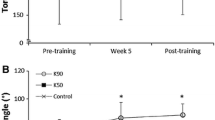Summary
Eight men (20–23 years) weight trained 3 days week−1 for 19 weeks. Training sessions consisted of six sets of a leg press exercise (simultaneous hip and knee extension and ankle plantar flexion) on a weight machine, the last three sets with the heaviest weight that could be used for 7–20 repetitions. In comparison to a control group (n = 6) only the trained group increased (P<0.01) weight lifting performance (heaviest weight lifted for one repetition, 29%), and left and right knee extensor cross-sectional area (CAT scanning and computerized planimetry, 11%, P<0.05). In contrast, training caused no increase in maximal voluntary isometric knee extension strength, electrically evoked knee extensor peak twitch torque, and knee extensor motor unit activation (interpolated twitch method). These data indicate that a moderate but significant amount of hypertrophy induced by weight training does not necessarily increase performance in an isometric strength task different from the training task but involving the same muscle group. The failure of evoked twitch torque to increase despite hypertrophy may further indicate that moderate hypertrophy in the early stage of strength training may not necessarily cause an increase in intrinsic muscle force generating capacity.
Similar content being viewed by others
References
Baratta R, Solomonow M, Zhou BH, Letson D, Chuinard R, D'Ambrosia R (1988) Muscular coactivation. The role of the antagonist musculature in maintaining knee stability. Am J Sports Med 16:113–122
Belanger AY, McComas AJ (1981) Extent of motor unit activation during effort. J Appl Physiol 51:160–167
Davies J, Parker DF, Rutherford OM, Jones DA (1988) Changes in strength and cross sectional area of the elbow flexors as a result of isometric strength training. Eur J Appl Physiol 57:667–670
Draganich LF, Jaeger RJ, Kralj AR (1989) Coactivation of the hamstrings and quadriceps during extension of the knee. J Bone Joint Surg [Am] 71:1075–1081
Duchateau J, Hainaut K (1984) Isometric or dynamic training: differential effects on mechanical properties of a human muscle. J Appl Physiol Respir Environ Exercise Physiol 56:296–301
Frontera WR, Meredith CN, O'Reilly KP, Knuttgen HG, Evans WJ (1988) Strength conditioning in older men: skeletal muscle hypertrophy and improved function. J. Appl Physiol 64:1038–1044
Ikai M, Fukunaga T (1970) A study on training effect on strength per unit cross-sectional area of muscle by means of ultrasonic measurement. Eur J Appl Physiol 28:173–180
Jones DA, Rutherford OM (1987) Human muscle strength training: the effects of three different regimes and the nature of the resultant changes. J Physiol (Lond) 391:1–11
Jones DA, Rutherford OM, Parker DF (1989) Physiological changes in skeletal muscle as a result of strength training. Q J Exp Physiol 74:233–256
Kandarian SC, White TP (1989) Force deficit during the onset of muscle hypertrophy. J Appl Physiol 67:2600–2607
Komi PV (1986) Training of muscle strength and power: interaction of neuromotoric, hypertrophic and mechanical factors. Int J Sports Med 7 [Suppl]:10–15
MacDougall JD, Ward GR, Sale DG, Sutton JR (1977) Biochemical adaptation of human skeletal muscle to heavy resistance training and immobilization. J Appl Physiol 43:700–703
MacDougall JD, Elder GCB, Sale DG, Moroz JR, Sutton JR (1980) Effects of strength training and immobilization on human muscle fibers. Eur J Appl Physiol 43:25–34
Maughan RJ (1984) Relationship between muscle strength and muscle cross-sectional area. Implications for training. Sports Med 1:263–269
Narici MV, Roi GS, Minetti AE, Cerretelli P (1989) Changes in force, cross-sectional area and neural activation during strength training and detraining of the human quadriceps. Eur J Appl Physiol 59:310–319
Osternig LR, Hamill J, Lander JE, Robertson R (1986) Co-activation of sprinter and distance runner muscles in isokinetic exercise. Med Sci Sports Exerc 18:431–435
Osternig LR, Robertson RN, Troxel RK, Hansen P (1990) Differential responses to proprioceptive neuromuscular facilitation (PNF) stretch techniques. Med Sci Sports Exerc 22:106–111
Rutherford OM, Jones DA (1986) The role of learning and coordination in strength training. Eur J Appl Physiol 55:100–105
Sale DG (1988) Neural adaptation to resistance exercise. Med Sci Sports Exerc 20:S135-S145
Sale DG, MacDougall JD, Jacobs I, Garner S (1990) Interaction between concurrent strength and endurance training. J Appl Physiol 68:260–270
Tesch PA, Hjort H, Balldin UI (1983) Effects of training on G tolerance. Aviat Space Environ Med 54:691–695
Vandervoort AA, Quinlan J, McComas AJ (1983) Twitch potentiation after voluntary contraction. Exp Neural 81:141–152
Author information
Authors and Affiliations
Rights and permissions
About this article
Cite this article
Sale, D.G., Martin, J.E. & Moroz, D.E. Hypertrophy without increased isometric strength after weight training. Europ. J. Appl. Physiol. 64, 51–55 (1992). https://doi.org/10.1007/BF00376440
Accepted:
Issue Date:
DOI: https://doi.org/10.1007/BF00376440




